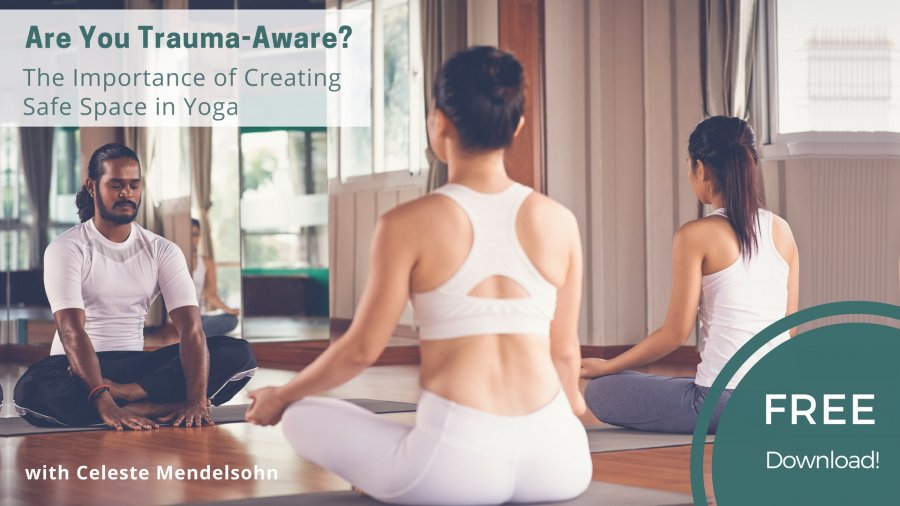Free Download! Are You Trauma-Aware? What Every Teacher Needs to Know about Creating Safe Space in Yoga
Course Info
- Price:
- $0.00
Celeste Mendelsohn
 Celeste Mendelsohn is a certified yoga teacher with a special focus on working with people in recovery. Her personal experience motivated her to develop Yoga Tarana. She was affected by the trauma of her family’s addictions and that of others who also struggle with the disease. She used her own...
Celeste Mendelsohn is a certified yoga teacher with a special focus on working with people in recovery. Her personal experience motivated her to develop Yoga Tarana. She was affected by the trauma of her family’s addictions and that of others who also struggle with the disease. She used her own... 
According to the most recent CDC data, as much as 23.5% of the general population has experienced at least one form of traumatic experience in their lives.
Also known as Adverse Childhood Experience (ACE), traumatic experiences are defined as stressful or traumatic events, which include not just physical events but emotional abuse and neglect. ACEs may also include household dysfunction or growing up with family members with substance use disorders.
Research has found that ACEs are strongly related to the development of numerous health problems throughout a person’s lifespan, including those associated with substance misuse.
The ramification of this statistic is that in a drop-in yoga class with 15 students, as many as 3-4 participants could have some degree of trauma etched into their tissues, notes IAYT-certified yoga therapist Celeste Mendelsohn in this free download.
As a consequence, she notes, it’s important for yoga teachers to understand the effects of trauma on body and mind. Celeste discusses the importance of building safety and trauma awareness into every yoga class and for all students, not just the ones who inform teachers of past troubles.
A specialist in working with people recovering from trauma and substance use disorder, Celeste points out that students don’t always share their histories.
“Generally, I would ask a new student coming to my yoga class if they had any issues that I needed to be aware of. I may get an answer about a sore rotator cuff or a lower back injury. But they’re not likely to tell me, ‘Yes, I witnessed my mother being beaten when I was five.’ We won’t always get the whole story–even with our regular students who walk into our class weekly or multiple times a week,” she says.
Celeste further discusses how yoga can help address the long-term effects of having lived through a traumatic event or childhood, provided teachers cultivate an extra level of sensitivity. She shares useful tools for teaching a trauma aware class. These include developing mindfulness of the cues we use, the intonations in our voices, and how we stand and move about the room to avoid disconcerting students with trauma issues. Sometimes something as innocuous as creative imagery or flowery language can cause students who are already doing their best to stay present to zone out.
“When you start talking about the beautiful energy that’s flowing up the spine and blossoming in your head, it sounds lovely,” says Celeste. “But if I have PTSD or I’m a trauma survivor and you said that to me in a class, dissociation is likely. My mind is gone and I’m going to miss the next several instructions.” This can elicit in that student shame and a feeling of being an outsider who can’t keep up with other class members.
Although we don’t always get the whole story, there are some clues to watch for when working with new students. These include gravitating to the back of the room, avoiding eye contact, or looking down when spoken to directly. But feelings of discomfort aside, the very act of making it into the room and onto the mat is a feat of heroic proportions for some. Yoga teachers can encourage them by developing the sensitivity to meet all of their students where they are.
How to begin? Celeste suggests finding a middle path vocally, speaking in a clear voice that allows a teacher to be heard without strain. She also advises, “Keep your voice level and be compassionate; Speak to them in front of them, never walk up beside them or from behind. Be in their vision when you come up to talk to them.”
Cueing should be concrete, using language that facilitates body awareness: “If you’re bringing your students into a Warrior II pose, instead of something flowery, say something like, “Press down through the back heel. Notice the sensations in your foot, in your leg. Press down through the ball of your right foot and find your body’s balance in the middle between the two.”
To learn much more about how to create classes that are engaging, useful, and available to students with all sorts of back stories, check out Celeste’s YogaUOnline class, Teaching Trauma-Aware Yoga – Creating a Healing Space.